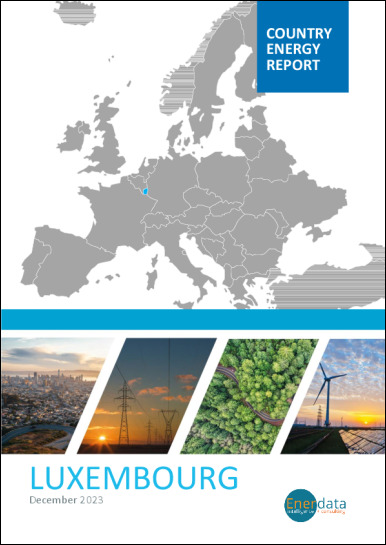- Update
-
- Format
- 3 files (PDF report, 2 Excel files)
- Pages
-
27 (Report only)
- Delivery
- Immediate by e-mail
- GENERAL OVERVIEW
- INSTITUTIONS AND ENERGY POLICY
- ENERGY COMPANIES
- ENERGY SUPPLY
- ENERGY PRICES
- ENERGY CONSUMPTION
- DATA TABLES
- ABBREVIATIONS
- GLOSSARY
Buy Luxembourg energy report
Price without VAT. Depending on your statute and location, VAT might be applicable. Get in touch with us for more information.
After validation, you will immediately receive 3 files by email (one pdf report and 2 excel files containing the datasets).
Overview
This analysis includes a comprehensive Luxembourg energy market report and updated datasets. It is derived from the most recent key economic indicators, supply and demand factors, oil and gas pricing trends and major energy issues and developments surrounding the energy industry. The report provides a complete picture of the country situation, dynamics, current issues and future prospects. With market data and continuous follow-up of markets news, this report brings clear and concise insights with which to tackle national energy challenges and opportunities. Browse the tabs below for a detailed table of contents, the list of graphs and tables, and details on the data files.
Highlights
- Luxembourg aims to reach a share of 37% of renewables in its final energy consumption in 2030 and to reduce its GHG emissions by 55%.
- Encevo is the dominant energy company.
- SEO operates the largest power plant.
- Almost three quarters of the electricity consumed is imported. The electricity produced is mostly coming from renewables.
- Gasoline and diesel prices have increased by around 15%/year since 2020.
- Electricity prices in industry have almost tripled since 2021 and have decreased by 3% for households.
- Energy consumption decreased by around 5% in 2023 after a 12% drop in 2022.
- Energy consumption per capita is two times higher than the EU average due to steel production and fuel tourism.
- Luxembourg plans to develop electricity interconnections with Belgium, Germany, and France.
Institutions & Energy Policy
The Ministry of Energy and Spatial Planning, through its Department of Energy, is responsible for the energy sector.
The Ministry of Environment, Climate, and Biodiversity oversees greenhouse gas (GHG) emission reduction policies.
The Luxembourg Institute of Regulation (ILR) regulates the electricity and gas markets.
Energy Companies
Gas:
Enovos is the sole importer and supplier of gas.
Energy Supply
Gas:
Luxembourg imports gas from Belgium and Germany through 4 interconnection points (0.6 bcm in 2023). In 2023, 99.7% of gas was imported from Belgium.

Source: CREOS
Energy Prices
Electricity:
Residential electricity prices surged by 64% in 2022 to 12.9€c/kWh and decreased by 5% in 2023 to 16.9€c/kWh; they rose by 24% from 2017 to 2020 before plateauing at around 19 €c/kWh.
Industrial prices rose by 67% in 2023 to 21.6€c/kWh, after a 62% surge in 2022. They had been rather stable previously.
Energy Consumption
The country's consumption per capita decreased by 7% to 4.5 toe in 2023, of which electricity accounts for about 0.9 MWh, which is around twice the EU average. Part of this high consumption is linked to steel production and to fuel tourism for motor fuels.
- GRAPH 1: CO2-energy Emissions (MtCO2)
- GRAPH 2: Installed electric capacity by source (2023, %)
- GRAPH 3: Gross power production by source (TWh)
- GRAPH 4: Power generation by source (2023, %)
- GRAPH 5: Gasoline & diesel prices (€/l)
- GRAPH 6: Electricity prices for industry and households (€c/kWh)
- GRAPH 7: Gas prices for industry and households (€c/kWh GCV)
- GRAPH 8: Consumption trends by energy source (Mtoe)
- GRAPH 9: Total consumption market share by energy (2023, %)
- GRAPH 10: Final consumption market share by sector (2023, %)
- Economic Indicators: Annual historical data including population, GDP growth, imports and exports, inflation rate, energy security and efficiency indicators, CO2 emissions.
- Supply Indicators: Historical data including oil and gas reserves, electric and refining capacity, energy production, power production and external trade. All are detailed by energy source.
- Demand Indicators: Historical data including consumption per inhabitant, consumption trends, total consumption by energy source, final consumption by energy source and sector, and electricity consumption by sector.
- Energy Balances: Single table displaying the overall energy industry balance per annum, also graphically displayed by energy sub-segment.
- Infrastructure Projects: Covers power plant projects by energy, technology, status and operator.
The Luxembourg energy market data since 1990 and up to
is included in the Excel file accompanying the Luxembourg country report.
It showcases the historical evolution, allowing users to easily work with the data.
Key Data included in the excelsheet:
- Economic indicators: Annual historical economic indicators, energy security, energy efficiency and CO2 emissions.
- Supply indicators: Annual historical reserves, capacity, production and external trade (imports(+) exports(-) balance).
- Demand indicators: Annual historical consumption per capita, consumption trends, total consumption, final consumption (per energy and per sector) and electricity consumption total and per sector.
- Energy Balance: total and per energy.
- Luxembourg Energy Prices: In addition to the analysis provided on the report we also provided a data set which includes historical details on the Luxembourg energy prices for the follow items: price of premium gasoline (taxes incl.), price of diesel (taxes incl.), price of electricity in industry (taxes incl.), price of electricity for households (taxes incl.), price of natural gas in industry (taxes incl.), prices of natural gas for households (taxes incl.), spot price of Brent and CO2 emissions (from fuel combustion).
 Energy and Climate Databases
Energy and Climate Databases Market Analysis
Market Analysis